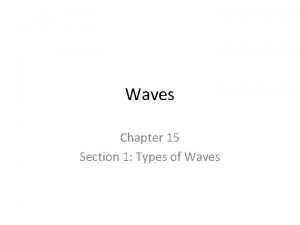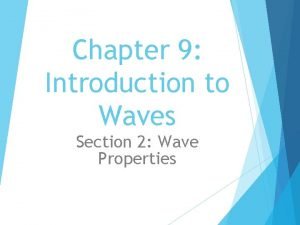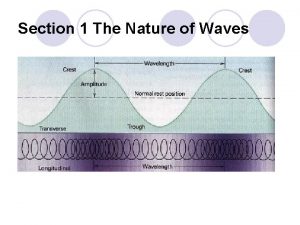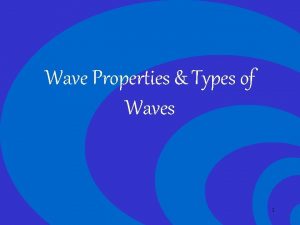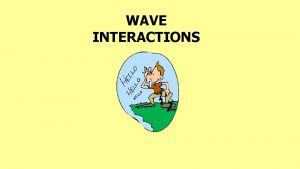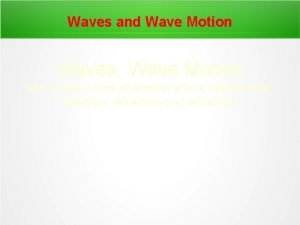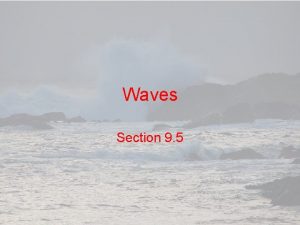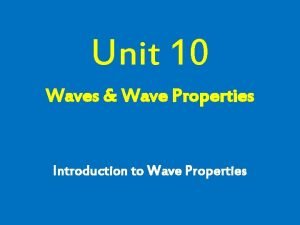Chapter 9 Introduction to Waves Section 2 Wave


















- Slides: 18

Chapter 9: Introduction to Waves Section 2: Wave Properties

Vocabulary Review vibration Copyright © Mc. Graw-Hill Education New • • crest trough compression rarefaction wavelength frequency period amplitude Wave Properties

The Parts of a Wave A transverse wave has alternating high points, called crests, and low points, called troughs. Wave Properties

The Parts of a Wave A longitudinal wave has no crests and troughs. When you make longitudinal waves with a coiled spring, a compression is a region where the coils are close together. Wave Properties

The Parts of a Wave The coils in the region next to a compression are spread apart, or less dense. This less-dense region of a longitudinal wave is called a rarefaction. Copyright © Mc. Graw-Hill Education Wave Properties

Wavelength A wavelength is the distance between one point on a wave and the nearest point just like it. For transverse waves the wavelength is the distance from crest to crest or trough to trough. Copyright © Mc. Graw-Hill Education Wave Properties

Wavelength A wavelength in a longitudinal wave is the distance between two neighboring compressions or two neighboring rarefactions. Copyright © Mc. Graw-Hill Education Wave Properties

Wavelength The wavelengths of sound waves that you can hear range from a few centimeters for the highest-pitched sounds to about 15 m for the deepest sounds. Copyright © Mc. Graw-Hill Education Wave Properties

Frequency and Period The frequency of a wave is the number of wavelengths that pass a fixed point each second. You can find the frequency of a transverse wave by counting the number of crests or troughs that pass by a point each second. Frequency is expressed in hertz (Hz). Copyright © Mc. Graw-Hill Education Wave Properties

Frequency and Period The period of a wave is the amount of time it takes one wavelength to pass a point. As the frequency of a wave increases, the period decreases. Period has units of seconds. Copyright © Mc. Graw-Hill Education Wave Properties

Wavelength is Related to Frequency As frequency increases, wavelength decreases. The frequency of a wave is always equal to the rate of vibration of the source that creates it. If you move the rope down, up, and back down in 1 s, the frequency of the wave you generate is 1 Hz. Copyright © Mc. Graw-Hill Education Wave Properties

Wavelength is Related to Frequency The speed of a wave depends on the medium it is traveling through. Sound waves usually travel faster through liquids and solids than they do through gases. However, light waves travel more slowly through liquids and solids than they do through gases or through a vacuum. Sound waves usually travel faster through warmer materials than through cooler materials. Copyright © Mc. Graw-Hill Education Wave Properties

Calculating Wave Speed You can calculate the speed of a wave represented by v by multiplying its frequency times its wavelength. Copyright © Mc. Graw-Hill Education Wave Properties

SOLVE FOR WAVE SPEED Use with Example Problem 1. Problem What is the speed of a sound wave that has a wavelength of 2. 00 m and a frequency of 170. 5 Hz? Copyright © Mc. Graw-Hill Education Wave Properties

Amplitude and Energy Amplitude is related to the amount of disturbance from a wave. The greater the wave’s amplitude is, the greater the disturbance that the wave produces. Amplitude is measured differently for longitudinal and transverse waves. Copyright © Mc. Graw-Hill Education Wave Properties

Amplitude of Longitudinal waves The amplitude of a longitudinal wave is related to how tightly the medium is pushed together at the compressions. The denser the medium is at the compressions, the larger the wave’s amplitude is and the more disturbance the wave creates. Copyright © Mc. Graw-Hill Education Wave Properties

Amplitude of Longitudinal Waves • The closer the coils are in a compression, the farther apart they are in a rarefaction. • The less dense the medium is at the rarefactions, the more energy the wave carries. Copyright © Mc. Graw-Hill Education Wave Properties

Amplitude of Transverse Waves The amplitude of any transverse wave is the distance from the crest or trough of the wave to the rest position of the medium. Copyright © Mc. Graw-Hill Education Wave Properties
 Transverse waves move perpendicular
Transverse waves move perpendicular Sound waves are longitudinal waves true or false
Sound waves are longitudinal waves true or false What are the mechanical waves
What are the mechanical waves What is a rainbow
What is a rainbow Characteristics of a longitudinal wave
Characteristics of a longitudinal wave Whats a reflected sound wave
Whats a reflected sound wave Short wave vs long wave radiation
Short wave vs long wave radiation Mechanical waves and electromagnetic waves similarities
Mechanical waves and electromagnetic waves similarities Electromagnetic waves vs mechanical waves
Electromagnetic waves vs mechanical waves Similarities of mechanical and electromagnetic waves
Similarities of mechanical and electromagnetic waves Surface waves and body waves
Surface waves and body waves Seismic waves are mechanical waves
Seismic waves are mechanical waves Compare and contrast p waves and s waves using venn diagram
Compare and contrast p waves and s waves using venn diagram Mechanical waves and electromagnetic waves
Mechanical waves and electromagnetic waves Difference between constructive and destructive waves
Difference between constructive and destructive waves Chapter 15 section 1 types of waves answer key
Chapter 15 section 1 types of waves answer key The nature of waves chapter 10 section 1
The nature of waves chapter 10 section 1 Chapter 9 introduction to waves
Chapter 9 introduction to waves Ability of two or more waves to combine and form a new wave
Ability of two or more waves to combine and form a new wave















